The retail cost of electricity in San Diego is already among the highest in the nation, and there are no signs the prices will be coming back down.
The latest San Diego Gas and Electric (SDG&E) budget request is calling for more rate hikes in 2024 with the local cost of electricity sticking to a steady upward trajectory.
California’s average price for a kilowatt of electricity in February 2022, enough to power a 100-watt light-bulb for 10 hours, sits at 25.59 cents. Only Hawaii, Connecticut and Rhode Island had higher rates.
Locally, prices are even higher, topping 27 cents a kilowatt hour. And if a typical customer uses 600 kwh a month, that’s an electricity bill north of 160 dollars.
“We’re recognizing, and we’ve always acknowledged that, we have higher rates here at SDGE,” said Scott Crider, SDGE vice president of customer service and external affairs.
The utility's latest budget filing with the California Public Utilities Commission says customers can expect average bills to climb another nine dollars a month in 2024. That depends on regulatory approval of the spending blueprint.
Crider said the utility forecasts energy consumption will double by 2045 and the local power grid needs to be upgraded to deal with it.
“It’s on really empowering the energy transition so we can handle more renewable energy, more battery storage and to be able to charge an increasing number of electric vehicles in the region,” Crider said
The costs for those grid improvements, and other upgrades, are baked into the cost of kilowatts that customers buy.
Many utilities use a volume approach to determine what to charge for electricity.
“When you buy carrots at the grocery store, isn’t that how they charge for carrots?” said Ahmad Faruqui, an economist who specializes in utility rate structures. “You buy more, you pay more. You buy less, you pay less.”
In fact, the way people pay for electricity is a lot like going to a market.
First, customers must buy a basket big enough for the biggest shopping trip of the year. That’s called a capacity cost.
Add lettuce and tomatoes into the basket, to represent transmission and distribution, and that accounts for nearly two-thirds of the cost of a kilowatt-hour.
The actual cost of making the electricity — a couple of potatoes — is close to another third.
Sundries like public purpose programs and debt service for purchases made years ago make up the rest.
But there is one crucial difference.
“If you don’t like the prices at Safeway, you can go to five other grocery stores,” Faruqui said. “If you don’t like the price of United Airlines tickets, you have 10 other options to look at. There is competition.”
But there is no discernible competition in California’s electricity marketplace and utilities play a huge role in setting the price.
In fact, utilities set the price — and then regulators at the CPUC review, adjust and sign off on the utility’s kilowatt rates.
But those rates also include things the utilities can’t control.
Regulators insist on conservation and state lawmakers want things like rooftop solar, so utilities have to adjust rates upward.
In the end, the utilities have to sell enough energy to cover costs.
“So if the forecast is wrong and they collected a million dollars less than we decided they were supposed to, we’ll try to set the rates so they’re going to collect a million dollars the next year. To make up for it,” said Mike Campbell of the CPUC Public Advocate’s office.
And that means regulators essentially guarantee a utility gets so much money, and if they do not, then customers pay more.
Utilities also make a profit, which comes from building infrastructure, and SDG&E is projecting a huge need.
“You think about almost doubling the capacity of the electric grid in about 20 years or so,” Crider said. “And so this is going to be an ongoing journey that we’re going to have to go on with our customers.”
And that journey will be costly.
“Everyone is projecting rate increases of 10% to 20%, on top of already-high rates,” Faruqui said. “And customers are pretty much fed up with it right? Affordability is a big challenge.”









